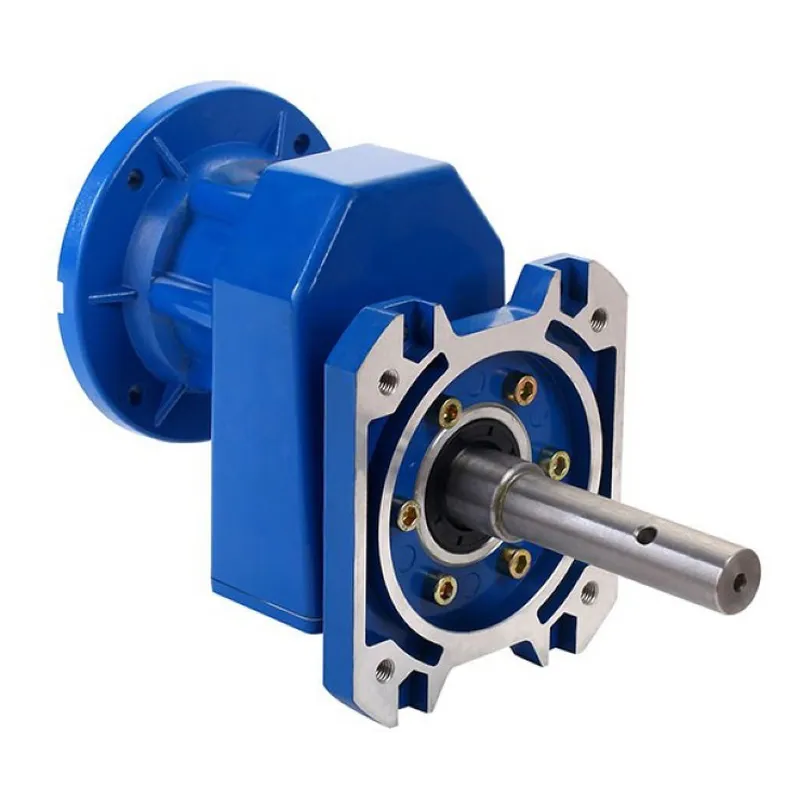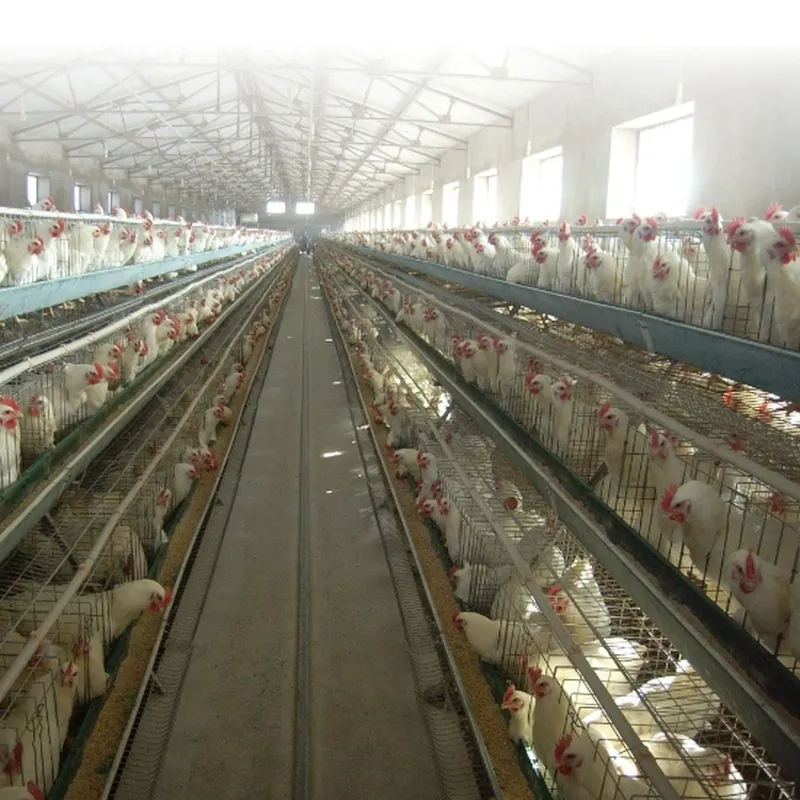The high torque poultry feeder gearbox is a specialized mechanical component designed specifically for use in poultry farm feeding systems that require high levels of torque to efficiently distribute feed to poultry houses. This gearbox is engineered to deliver substantial output torque while maintaining the necessary speed for smooth and consistent feed distribution.
Constructed with robust materials and precision-engineered gears, the high torque gearbox can handle heavy loads and resist wear and tear, making it ideal for demanding poultry farm environments. Its design enables it to transmit power effectively from the electric motor to various feeding mechanisms such as conveyor belts, augers, or paddle wheels, ensuring reliable feed delivery even under heavy loads or challenging conditions.

Key Advantages:
Using a high torque poultry feeder gearbox in poultry farm feeding systems offers several distinct advantages that contribute to improved efficiency, reliability, and productivity. Here are the key benefits:
- Efficient Power Transmission: High torque gearboxes are specifically designed to transmit power effectively, allowing for the efficient conversion of the motor's rotational energy into the necessary torque required to drive feeding mechanisms such as conveyor belts or augers. This efficiency minimizes energy loss during transmission, resulting in reduced energy consumption and lower operational costs.
- Handling Heavy Loads: High torque gearboxes are capable of handling heavy loads encountered in poultry farm feeding systems. They can reliably distribute feed to multiple poultry houses, even when operating under maximum load conditions, ensuring consistent feed delivery without compromising performance.
- Smooth and Consistent Feed Distribution: The high torque output of these gearboxes enables smooth and consistent feed distribution throughout the feeding system. This ensures that all poultry receive the necessary nutrition without experiencing interruptions or uneven distribution, promoting uniform growth and overall flock health.
- Durability and Longevity: High torque gearboxes are constructed from durable materials and feature robust designs to withstand the demanding conditions of poultry farm environments. They are engineered to resist wear, corrosion, and fatigue, ensuring long-term reliability and extended service life with minimal maintenance requirements.
- Optimized Feeding Operations: By providing the necessary torque to drive feeding mechanisms efficiently, high torque gearboxes optimize feeding operations in poultry farms. They enable precise control over feed distribution rates and ensure timely delivery of feed to meet the nutritional needs of the poultry, resulting in improved feed utilization and reduced wastage.
- Versatility and Adaptability: High torque gearboxes offer versatility and adaptability, allowing them to be integrated into various types of feeding systems and configurations. Whether used in chain feeding systems, pan feeding systems, or other feeding mechanisms, these gearboxes can be customized to meet the specific requirements of different poultry farm setups.

Applications of High Torque Poultry Feeder Gearbox
High torque poultry feeder gearboxes find numerous applications within poultry farm feeding systems, where their capability to deliver substantial torque efficiently is essential for various tasks. Here are the key applications of high torque poultry feeder gearboxes:
- Conveyor Belt Systems: High torque gearboxes are used to drive conveyor belt systems that transport feed from storage bins to feeding stations across poultry houses. These gearboxes ensure smooth and consistent movement of the conveyor belts, even when handling heavy loads of feed.
- Auger Feeding Systems: Auger feeding systems rely on high torque gearboxes to drive the auger mechanisms responsible for moving feed from storage silos to distribution points. The gearboxes provide the necessary torque to ensure efficient feed delivery, especially in applications where feed needs to be lifted vertically or conveyed over long distances.
- Paddle Wheel Feeders: Paddle wheel feeders utilize high torque gearboxes to drive the rotating paddles that distribute feed evenly across feeding troughs or pans. These gearboxes ensure that the paddles can effectively agitate and dispense feed without stalling, even when dealing with dense or sticky feed materials.
- Chain Feeding Systems: In chain feeding systems, high torque gearboxes power the chains that carry feed along the feeding lines, ensuring uniform distribution to poultry housed in multiple compartments or cages. The gearboxes provide the necessary torque to propel the chains and overcome resistance, allowing for efficient feed delivery.
- Feed Mixing and Blending Equipment: High torque gearboxes are employed in feed mixing and blending equipment, such as paddle mixers or ribbon blenders, used to prepare custom feed formulations. These gearboxes facilitate the thorough mixing of various feed ingredients, ensuring consistent nutrient distribution and quality in the final feed ration.
- Feed Pelleting Machines: Pelleting machines used to produce pelleted feed for poultry often incorporate high torque gearboxes to drive the extrusion and compression processes. These gearboxes provide the power required to compress feed ingredients into uniform pellets, facilitating efficient pellet production for enhanced feed digestibility and nutrient absorption.

Working Principle:
The working principle of a high torque poultry feeder gearbox for a poultry farm feeding system involves the efficient transmission of power from the electric motor to various feeding mechanisms while delivering substantial torque output. Here's a detailed explanation of its working principle:
- Power Input: The operation begins with the electric motor supplying rotational energy to the gearbox. The motor typically runs at high speeds, providing the initial kinetic energy required for the gearbox to function.
- Gear Reduction: Inside the gearbox, the high-speed rotation from the motor is transmitted to a series of gears. These gears are specifically designed to reduce the rotational speed while increasing torque output. High torque gearboxes typically feature gear ratios that prioritize torque multiplication over speed reduction, ensuring the gearbox can handle heavy loads encountered in poultry feeding systems.
- Torque Amplification: As the rotational speed decreases, the torque output of the gearbox increases proportionally. This torque amplification is essential for driving feeding mechanisms such as conveyor belts, augers, or paddle wheels, which require substantial force to overcome resistance and distribute feed efficiently.
- Output Delivery: The transformed output with lower speed and higher torque is delivered through the output shaft of the gearbox. This shaft connects directly to the feeding mechanisms, transferring the torque to drive their operation. Whether it's rotating paddles in a paddle wheel feeder or driving the chain in a chain feeding system, the gearbox ensures that the required torque is supplied consistently to power the feeding process.
- Control and Regulation: High torque gearboxes often feature adjustable speed and torque settings, allowing operators to control the rate of feed distribution according to specific requirements. This control and regulation capability ensure precise feed delivery, preventing overfeeding or underfeeding and optimizing feed utilization.

Proper Maintenance of High Torque Poultry Feeder Gearbox
Proper maintenance of a high torque poultry feeder gearbox is crucial for ensuring its efficient and reliable operation in poultry farm feeding systems. Here are essential maintenance practices to follow:
- Regular Lubrication: Ensure that the gearbox is adequately lubricated according to the manual's specifications. Use the recommended lubricant and adhere to the prescribed lubrication intervals to minimize friction and wear between moving parts.
- Inspect for Wear and Damage: Regularly inspect the gearbox for signs of wear, damage, or corrosion. Check gears, bearings, shafts, and seals for any abnormalities such as cracks, pitting, or excessive play. Promptly replace any worn or damaged components to prevent further deterioration and ensure optimal performance.
- Clean External Surfaces: Keep the exterior of the gearbox clean from dirt, dust, and debris that can accumulate over time. Use a brush or compressed air to remove buildup from vents, cooling fins, and other external surfaces to prevent overheating and maintain proper ventilation.
- Check Alignment: Periodically check the alignment of the gearbox with the motor and driven equipment. Misalignment can lead to premature wear and failure of gearbox components. Adjust the alignment as necessary to ensure proper meshing of gears and optimal power transmission.
- Monitor Operating Temperature: Regularly monitor the operating temperature of the gearbox during operation. Excessive heat can indicate overloading, inadequate lubrication, or other issues that may compromise gearbox performance. Take corrective action if the temperature exceeds recommended limits to prevent damage and ensure longevity.
- Inspect Seals and Gaskets: Check the integrity of seals and gaskets to prevent lubricant leaks and ingress of contaminants. Replace any damaged or worn seals to maintain the internal cleanliness of the gearbox and protect against moisture and debris intrusion.

Choose the Right High Torque Poultry Feeder Gearbox for Poultry Farm
Choosing the right high torque poultry feeder gearbox for a poultry farm involves careful consideration of several factors to ensure optimal performance, efficiency, and longevity. Here's a step-by-step guide to selecting the appropriate gearbox:
- Assess Torque Requirements: Determine the torque requirements of your poultry farm feeding system based on factors such as the size of the operation, the type of feeding mechanisms used (conveyor belts, augers, paddle wheels), and the amount of feed to be distributed. Choose a high torque gearbox capable of meeting or exceeding the maximum torque demands of your system to ensure reliable operation under heavy loads.
- Consider Gearbox Type: Evaluate different types of high torque gearboxes available, such as helical, worm, planetary, or bevel gearboxes. Each type offers distinct advantages in terms of torque transmission, efficiency, and durability. Select the gearbox type that best suits your specific application requirements and operational preferences.
- Evaluate Gear Ratio: Pay attention to the gear ratio of the gearbox, which determines the relationship between input speed and output torque. A higher gear ratio results in greater torque multiplication but may sacrifice speed. Choose a gearbox with an appropriate gear ratio that balances torque and speed requirements for optimal performance in your feeding system.
- Ensure Durability and Reliability: Prioritize durability and reliability when selecting a high torque poultry feeder gearbox. Look for gearboxes constructed from high-quality materials such as hardened steel or cast iron, with robust housing designs and effective sealing mechanisms to protect internal components from dust, moisture, and contaminants commonly found in poultry farm environments.
- Consider Environmental Factors: Consider the environmental conditions in which the gearbox will operate, including temperature variations, humidity levels, and exposure to corrosive substances. Choose a gearbox with suitable environmental protection features, such as corrosion-resistant coatings, IP ratings for ingress protection, and temperature-resistant seals, to ensure long-term performance and reliability in harsh agricultural settings.

Why Choose AGKNX's Poultry Feeding Gearbox?
AGKNX is a prominent manufacturer of high-performance poultry feeding gearboxes for a variety of applications. Our gearboxes are integral to various systems in poultry farming and pig livestock equipment. We provide customized services and have international certifications to ensure quality and reliability. Our technical staff can reconfigure an existing design or assist you in designing a custom poultry feeding gearbox if a standard or existing design does not fit your application. Shaft rotation, speed ratio, input speed, output speed, input torque, output torque, mounting position, and the application's environment are all considerations when choosing a poultry feeding gearbox. If you want to buy a poultry feeding gearbox, please get in touch with us.
Professionalism
Our technical staff can assist you in designing custom poultry feeding gearboxes to meet your specific requirements.
International Certifications
We adhere to international quality standards to ensure the performance and durability of our products.
Customized Services
We offer tailored solutions to fit your unique poultry farming needs.
Production Facilities
Our state-of-the-art production facilities ensure the highest quality standards in manufacturing.
After-sales Services
We provide comprehensive after-sales support to ensure the continued efficiency of our poultry feeding gearboxes.

Author: Yjx
